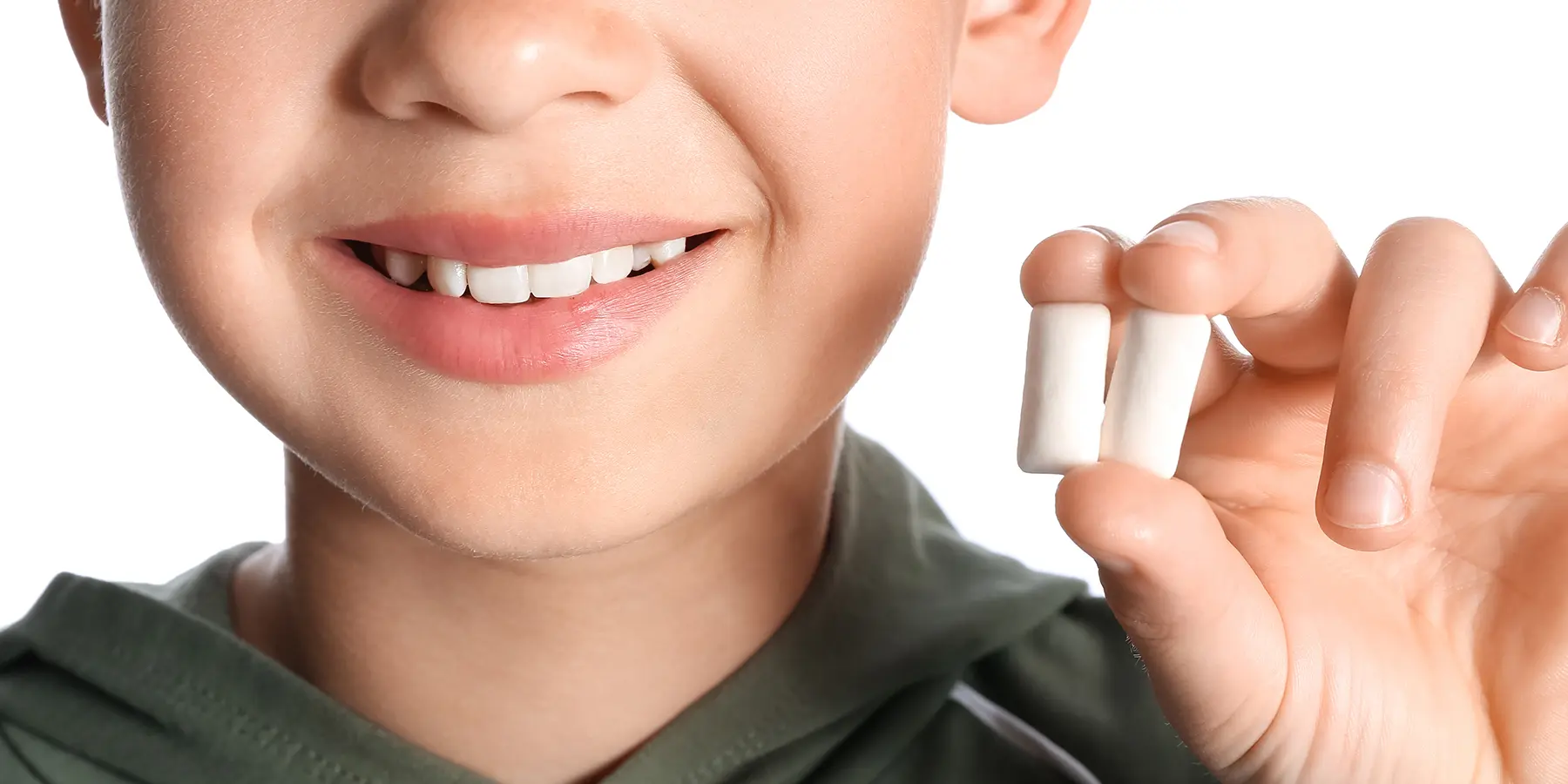
The Tooth-Friendly Benefits of Chewing Gum
Reviewed by Paul Rubin
Reading time: four minutes
Chewing gum is often thought of as a treat, but when chosen wisely, it can actually be good for your teeth. While sticky, sugary gum can promote cavities, sugar-free gum can help clean the mouth and protect enamel.
Table of Contents
Key Takeaway
Chewing sugar-free or xylitol gum can actually benefit your child’s dental health by stimulating saliva, neutralizing acids, and protecting enamel. When chewed responsibly and paired with good brushing habits and regular dental checkups, it’s a simple, tooth-friendly way to keep young smiles fresh and healthy.
Is Chewing Gum Bad for Your Teeth?
Whether gum helps or harms your smile depends entirely on what it’s made of. Traditional gum sweetened with sugar can increase plaque and feed the bacteria that cause cavities. In contrast, sugar-free gum—especially those containing xylitol—can help maintain a healthy mouth. It stimulates saliva production, balances mouth acids, and even strengthens enamel over time.
How Sugar-Free Gum Protects Teeth
Chewing sugar-free gum after meals offers several oral health benefits that can complement your child’s brushing routine:
- Encourages saliva flow that rinses away leftover food and debris.
- Neutralizes harmful acids in the mouth, protecting enamel from erosion.
- Strengthens tooth surfaces by replenishing calcium and phosphate.
- Reduces dry mouth symptoms that can make kids more prone to cavities.
By swapping sugary gum for sugar-free options, your child can enjoy a treat that’s great for their smile.
Xylitol Gum Benefits
Xylitol is a naturally occurring sweetener found in fruits and vegetables. It has a pleasant sweetness but doesn’t feed the bacteria responsible for tooth decay. In fact, xylitol can stop these oral bacteria from sticking to the teeth, reducing plaque buildup over time.
Why Xylitol Gum Is a Smart Choice
Xylitol gum offers several protective benefits for growing smiles:
- Fights cavities naturally by reducing the bacteria that cause decay.
- Keeps enamel strong by maintaining a balanced pH in the mouth.
- Freshens breath and reduces plaque-causing bacteria.
- Safe for kids when chewed responsibly under supervision.
To get the most benefit, choose a gum where xylitol is listed as the first ingredient.
When Age Can Kids Chew Gum?
Most pediatric dentists recommend waiting until around age 4 or 5, when children can fully understand that gum is for chewing, not swallowing. Some kids may need a little more time, depending on their maturity and ability to follow directions.
Tips for Introducing Gum Safely
When your child is ready to try gum, a few simple guidelines can help make it a positive experience:
- Start with small pieces of sugar-free or xylitol gum.
- Teach your child to throw gum away properly after chewing.
- Supervise at first to be sure they don’t swallow it.
- Skip gum if your child wears braces or other dental appliances unless approved by your dentist.
With these habits in place, chewing gum can become a safe and tooth-friendly routine.
The Best Time to Chew Gum
Gum can’t replace brushing and flossing, but it’s a great complement between cleanings.
Chewing sugar-free gum is most helpful:
- After meals or snacks to wash away food particles and acids
- After sugary drinks like juice or sports drinks to balance mouth pH
- Between brushings when kids are at school or on the go
By making sugar-free gum part of your child’s daily routine, you can help protect their smile even when a toothbrush isn’t nearby.
When Gum Should Be Avoided
Avoid giving gum if your child has jaw pain, has been diagnosed with TMJ disorder, or wears braces and retainers that could trap sticky pieces. Gum is also not recommended for very young children or anyone who still has trouble remembering not to swallow it.
If you’re unsure whether gum is appropriate, your pediatric dentist can help you decide what’s best for your child’s smile.
Chew Smarter for a Healthier Smile
Curious about how gum fits into your child’s dental routine? Ask your pediatric dentist about it at your child’s next check up!
To book an appointment at our pediatric dental office in Prosper, TX, call (469) 228-4402, request an appointment online, or visit us at 240 S. Preston Road, Suite 10 Prosper, TX 75078.
📍Other locations
Lonestar Kid’s Dentistry in Frisco, TX
Lonestar Kid’s Dentistry in McKinney, TX
FAQ
Not when it’s sugar-free. Gums with sugar can lead to decay, but sugar-free and xylitol gum can actually reduce plaque and protect enamel by increasing saliva flow. Chewing sugarless gum after meals is even recommended by many dentists as part of a healthy dental health routine.
Most children are ready around ages 4 or 5, once they can chew without swallowing. Always supervise young children and choose sugar-free options. Regular dental checkups are the best time to ask your dentist if your child is ready.
Xylitol gum helps fight bacteria, keep enamel strong, freshen breath, and reduce the risk of cavities—all while satisfying a sweet tooth. Because xylitol doesn’t act like sugar or other artificial sweeteners, it’s safer for developing teeth.
Look for sugar-free or xylitol gum with the ADA Seal of Acceptance. Avoid sugary or sticky gums that can damage enamel or dental work. If your child has jaw pain or temporomandibular joint issues, ask your dentist before introducing gum to avoid strain.
